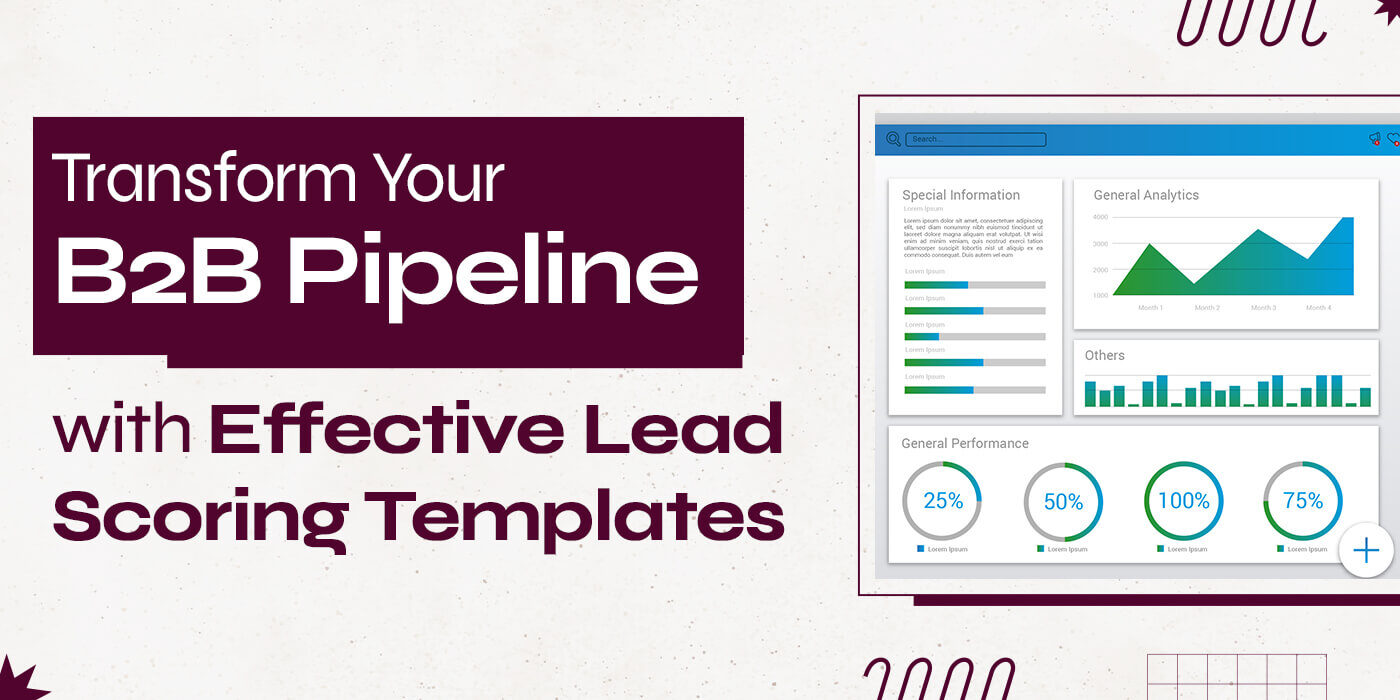
Transform Your B2B Pipeline with Effective Lead Scoring Templates
Every sales and marketing team aims to quickly and efficiently identify high-quality leads. The challenge lies in evaluating
-Which leads are ready to convert?
-Which aren’t worth the time?
A lead scoring template can solve this problem, helping you objectively assess leads based on behaviors and attributes specific to your ideal customer profile (ICP).
This guide introduces free lead scoring templates, breaks down their key components, and showcases industry-specific examples for applying them effectively.
Why Use a Lead Scoring Template?
Lead scoring templates provide a structured, standardized approach to evaluating leads. By defining and scoring the most relevant criteria for your target audience, you can prioritize high-intent prospects, streamline lead qualification, and shorten sales cycles.
According to Gleanster Research, companies using lead-scoring models see a 73% increase in conversion rates, making it a powerful asset for sales and marketing alignment.
Templates also unify marketing and sales teams by offering an objective view of lead quality. With everyone on the same page, you can avoid confusion about lead readiness and focus resources on leads that genuinely fit your ICP.
Now, let’s look at how a lead scoring template can set you up for success.
Structure and Key Components of a Lead Scoring Template
The lead scoring template features a scoring range of 0-100 points and is designed to be flexible and customizable for any business. It is structured for ease and efficiency and features weighted scoring, automated total calculations, and adjustable criteria fields.
Template Breakdown
- Criteria Selection: Identify core attributes and actions indicating buying potential, such as job title, company size, content engagement, and product interest. For example, if your ICP includes senior management, criteria like “VP” or “CMO” should be prioritized.
- Weight Assignment: Assign higher weights to criteria closely aligning with your ICP. For instance, if decision-making authority is crucial, a “CMO” title may hold more weight than location or company size.
- Completion Tracking: Track each lead's completion of criteria, noting when they meet key conditions such as downloading a product brochure or viewing the pricing page.
- Automatic Score Calculation: The template calculates each lead’s total score instantly, allowing your sales team to see their qualification level at a glance.
Below is an example of a basic B2B lead scoring template structure:

Industry-Specific Lead Scoring Templates
Lead scoring criteria vary significantly by industry. Here are examples tailored to five sectors to illustrate how you can customize the template for specific B2B needs.
1. SaaS and B2B Software Lead Scoring Template
For SaaS companies, lead scoring focuses on digital engagement and product interest. Potential clients typically research software solutions before reaching out.

For instance, frequent visits to your demo page or downloading product-focused content signal strong buying intent. Adding negative scoring, such as deducting points if a lead repeatedly unsubscribes or remains inactive, can also be helpful.
2. Real Estate Lead Scoring Template
Real estate lead scoring often emphasizes financial readiness and location-specific interest due to the nature of property purchases.

A lead with a budget of over $500k and a short buying timeline signals high buying potential. Deducting points for low engagement, like unsubscribing from listings, can also help maintain lead quality.
3. Financial Services Lead Scoring Template
Financial services often require leads to demonstrate financial capacity and engagement with compliance-oriented content.

High net worth and investment urgency are key indicators, while client referrals or attendance at industry webinars may further enhance a lead’s score.
4. E-commerce Lead Scoring Template
For e-commerce, demographic data and purchase behavior are useful indicators for predicting repeat purchases or upgrades.

High scores for cart additions and past purchases reflect engagement, with deductions for abandoned carts or inactivity.
5. Sales and Leadership Coaching Template
For coaching services, leads are often scored based on career level, income, and engagement with educational content.

A lead attending webinars and downloading content shows active interest, while lack of engagement may lead to negative scoring.
Top Tips for Effective Lead Scoring
- Define Your ICP in Detail: Tailoring criteria to your ICP will ensure you’re scoring the right leads.
- Use Negative Scoring: Apply negative scores for low engagement (e.g., email opt-outs) to maintain lead quality.
- Regularly Review and Update Scores: As market trends shift, adjust criteria weights to keep scoring relevant.
Implementing and Automating Your Lead Scoring Template
Automating lead scoring in a CRM like HubSpot or Salesforce ensures real-time updates, allowing sales teams to see top-scoring leads instantly. By automating, you reduce the risk of outdated scores and maintain lead quality consistently.

.jpg?width=60&name=deepti%20(2).jpg)


